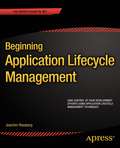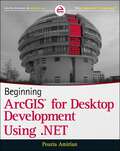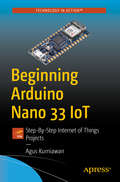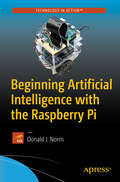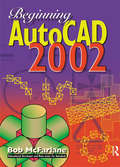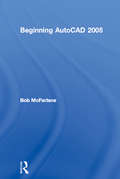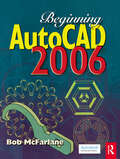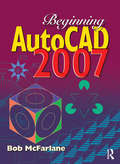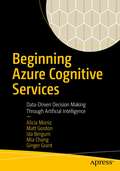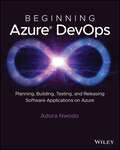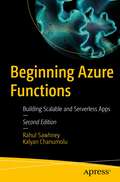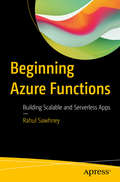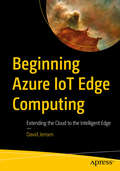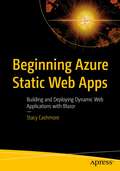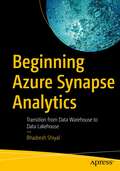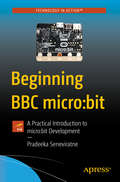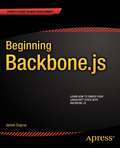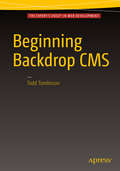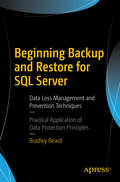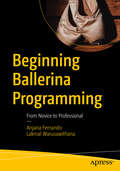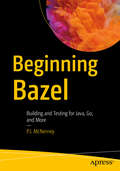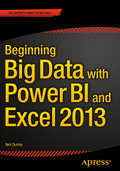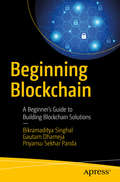- Table View
- List View
Beginning Application Lifecycle Management
by Joachim RossbergBeginning Application Lifecycle Management is a guide to an area of rapidly growing interest within the development community: managing the entire cycle of building software. ALM is an area that spans everything from requirements specifications to retirement of an IT-system or application. Because its techniques allow you to deal with the process of developing applications across many areas of responsibility and across many different disciplines, the benefits and effects of ALM techniques used on your project can be wide-ranging and pronounced. In this book, author Joachim Rossberg will show you what ALM is and why it matters. He will also show you how you can assess your current situation and how you can use this assessment to create the road ahead for improving or implementing your own ALM process across all of your team's development efforts. Beginning Application Lifecycle Management can be implemented on any platform. This book will use Microsoft Team Foundation Server as a foundation in many examples, but the key elements are platform independent and you'll find the book written in a platform agnostic way. In this book, you'll learn: What application lifecycle management is and why it matters. The steps necessary for implementing an ALM process. Tips and techniques you can use to gain control of your development efforts. How to implement an agile framework into your ALM processHow to achieve traceability and visibility in your projectsHow to automate your ALM process
Beginning ArcGIS for Desktop Development using .NET
by Pouria AmirianGet the very most out of the ArcGIS for Desktop products through ArcObjects and .NETArcGIS for Desktop is a powerful suite of software tools for creating and using maps, compiling, analyzing and sharing geographic information, using maps and geographic information in applications, and managing geographic databases. But getting the hang of ArcGIS for Desktop can be a bit tricky, even for experienced programmers. Core components of ArcGIS platform is called ArcObjects. This book first introduce you the whole ArcGIS platform and the opportunities for development using various programming languages. Then it focuses on ArcGIS for Desktop applications and makes you familiar with ArcObjects from .NET point of view. Whether you are an ArcGIS user with no background in programming or a programmer without experience with the ArcGIS platform, this book arms you with everything you need to get going with ArcGIS for Desktop development using .NET?right away. Written by a leading expert in geospatial information system design and development, it provides concise, step-by-step guidance, illustrated with best-practices examples, along with plenty of ready-to-use source code. In no time you?ll progress from .NET programming basics to understanding the full suite of ArcGIS tools and artefacts to customising and building your own commands, tools and extensions?all the way through application deployment. Among other things, you?ll learn to:Object-Oriented and Interface-based programming in .NET (C# and VB.NET) Finding relationship between classes and interfaces using object model diagramsQuerying dataVisualizing geographical data using various renderingCreating various kinds of Desktop Add-Ins Performing foreground and background geoprocessingLearn how to improve your productivity with ArcGIS for Desktop and Beginning ArcGIS for Desktop Development Using .NET
Beginning Arduino
by Michael McrobertsWant to light up a display? Control a touch screen? Program a robot? The Arduino is a microcontroller board that can help you do all of these things, plus nearly anything you can dream up. Even better, it's inexpensive and, with the help of Beginning Arduino, Second Edition, easy to learn. In Beginning Arduino, Second Edition, you will learn all about the popular Arduino by working your way through a set of 50 cool projects. You'll progress from a complete Arduino beginner to intermediate Arduino and electronic skills and the confidence to create your own amazing projects. You'll also learn about the newest Arduino boards like the Uno and the Leonardo along the way. Absolutely no experience in programming or electronics required! Each project is designed to build upon the knowledge learned in earlier projects and to further your knowledge of Arduino programming and electronics. By the end of the book you will be able to create your own projects confidently and with creativity. You'll learn about: Controlling LEDs Displaying text and graphics on LCD displays Making a line-following robot Using digital pressure sensors Reading and writing data to SD cards Connecting your Arduino to the Internet This book is for electronics enthusiasts who are new to the Arduino as well as artists and hobbyists who want to learn this very popular platform for physical computing and electronic art. Please note: The print version of this title is black and white; the eBook is full color. The color fritzing diagrams are available in the source code downloads on http://www. apress. com/9781430250166 What you'll learn Controlling LEDs Displaying text and graphics on LCD displays Making a line-following robot Using digital pressure sensors Reading and writing data to SD cards Connecting your Arduino to the Internet Who this book is for Electronics enthusiasts who are new to the Arduino as well as artists and hobbyists who want to learn this very popular platform for physical computing and electronic art. Table of Contents Introduction Light 'Em Up LED Effects Simple Sounders and Sensors Driving a DC Motor Binary Counters LED Displays Liquid Crystal Displays Servos Steppers and Robots Pressure Sensors Touch Screens Temperature Sensors Ultrasonic Rangefinders Reading and Writing to an SD Card Making an RFID Reader Communicating over Ethernet
Beginning Arduino Nano 33 IoT: Step-By-Step Internet of Things Projects
by Agus KurniawanDevelop Internet of Things projects with Sketch to build your Arduino programs. This book is a quick reference guide to getting started with Nano 33 IoT, Arduino’s popular IoT board. You’ll learn how to access the Arduino I/O, understand the WiFi and BLE networks, and optimize your board by connecting it to the Arduino IoT Cloud. Arduino Nano 33 IoT is designed to build IoT solutions with supported WiFi and BLE networks. This board can be easily extend through I/O pins, sensors and actuators. Beginning Arduino Nano 33 IoT is the perfect solution for those interested in learning how to use the latest technology and project samples through a practical and content-driven approach. What You’ll LearnPrepare and set up Arduino Nano 33 IoT boardOperate Arduino Nano 33 IoT board hardware and softwareDevelop programs to access Arduino Nano 33 IoT board I/OBuild IoT programs with Arduino Nano 33 IoT boardWho This Book Is ForMakers, developers, students, and professional of all levels.
Beginning Artificial Intelligence with the Raspberry Pi
by Donald J. NorrisGain a gentle introduction to the world of Artificial Intelligence (AI) using the Raspberry Pi as the computing platform. Most of the major AI topics will be explored, including expert systems, machine learning both shallow and deep, fuzzy logic control, and more! AI in action will be demonstrated using the Python language on the Raspberry Pi. The Prolog language will also be introduced and used to demonstrate fundamental AI concepts. In addition, the Wolfram language will be used as part of the deep machine learning demonstrations. A series of projects will walk you through how to implement AI concepts with the Raspberry Pi. Minimal expense is needed for the projects as only a few sensors and actuators will be required. Beginners and hobbyists can jump right in to creating AI projects with the Raspberry PI using this book. What You'll Learn What AI is and--as importantly--what it is not Inference and expert systems Machine learning both shallow and deep Fuzzy logic and how to apply to an actual control system When AI might be appropriate to include in a system Constraints and limitations of the Raspberry Pi AI implementation Who This Book Is For Hobbyists, makers, engineers involved in designing autonomous systems and wanting to gain an education in fundamental AI concepts, and non-technical readers who want to understand what AI is and how it might affect their lives.
Beginning AutoCAD 2002
by Bob McFarlaneNew features in AutoCAD 2002 are covered in this book, making it a useful refresher course for anyone using AutoCAD at this level, and upgrading to the new software release. The material in the book is also relevant to anyone using other recent releases, including, AutoCAD 2000.
Beginning AutoCAD 2005
by Bob McFarlaneBeginning AutoCAD 2005 is a course based on learning and practising the essentials of 2D drawing using AutoCAD. Bob McFarlane’s hands-on approach is uniquely suited to independent learning and use on courses. The focus on 2D drawing in one book, ensures the reader gets a thorough grounding in the subject, with a greater depth of coverage than tends to be available from general introductions to AutoCAD. As a result, this book provides a true, step-by-step, detailed exploration of the AutoCAD functions required at each stage of producing a 2D drawing – an approach often not found in the many software reference guides available.The emphasis on learning through doing makes this book ideal for anyone involved in engineering, construction or architecture – where the focus is on productivity and practical skills. The author has also matched the coverage to the requirements of City and Guilds, Edexcel (BTEC) and SQA syllabuses.New features in AutoCAD 2005 are covered in this book including: Drafting Tools; Drawing Management; Drawing Output; Plot and Publish Tools; Productivity Tools; Sheet Set Manager, and Tool Palette Enhancements. The result is a useful refresher course for anyone using AutoCAD at this level, and those upgrading to the new software release. The course is also designed to be fully relevant to anyone using other recent releases, including AutoCAD 2004.Bob McFarlane is Curriculum Manager for CAD and New Media at Motherwell College, Scotland, and an Autodesk Educational Developer.
Beginning AutoCAD 2006
by Bob McFarlaneBeginning AutoCAD 2006 is a course based on learning and practising the essentials of 2D drawing using AutoCAD. Bob McFarlane’s hands-on approach is uniquely suited to independent learning and use on courses. The focus on 2D drawing in one book ensures the reader gets a thorough grounding in the subject, with a greater depth of coverage than tends to be available from general introductions to AutoCAD. As a result, this book provides a true, step-by-step, detailed exploration of the AutoCAD functions required at each stage of producing a 2D drawing – an approach often not found in the many software reference guides available.The emphasis on learning through doing makes this book ideal for anyone involved in engineering, construction or architecture – where the focus is on productivity and practical skills. The author has also matched the coverage to the requirements of City and Guilds, Edexcel (BTEC) and SQA syllabuses.New features in AutoCAD 2006 are covered in this book including: DYN (dynamic input showing coordinate position and lengths – an important new feature of the latest AutoCAD software), as well as new commands in the Modify and Dimension tool set. The result is a useful refresher course for anyone using AutoCAD at this level, and those upgrading to the new software release. The course is also designed to be fully relevant to anyone using other recent releases, including AutoCAD 2005.
Beginning AutoCAD 2007
by Bob McFarlaneBeginning AutoCAD 2007 is a course based on learning and practising the essentials of 2D drawing using AutoCAD. Bob McFarlane's hands-on approach is uniquely suited to independent learning and use on courses. The focus on 2D drawing in one book ensures the reader gets a thorough grounding in the subject, with a greater depth of coverage than tends to be available from general introductions to AutoCAD. As a result, this book provides a true, step-by-step, detailed exploration of the AutoCAD functions required at each stage of producing a 2D drawing - an approach often not found in the many software reference guides available.The emphasis on learning through doing makes this book ideal for anyone involved in engineering, construction or architecture - where the focus is on productivity and practical skills. The author has also matched the coverage to the requirements of City and Guilds, Edexcel (BTEC) and SQA syllabuses.The following new features in AutoCAD 2007 are covered in this book:* Create: Using enhanced commands and draughting tools to create all types of content* Manage: Using the Sheet Set Manager and Attribute Extraction to manage data and information* Produce: Using dynamic blocks, dynamic input and selection preview to increase productivity* Share: Using e-transmit, publish to the web and PDF files to share informationPlus, a new companion website features AutoCAD files for selected activities for students to work with.The result is a useful refresher course for anyone using AutoCAD at this level, and those upgrading to the new software release. The course is also designed to be fully relevant to anyone using other recent releases, including AutoCAD 2006.ABOUT THE AUTHOR Bob McFarlane has been writing books on AutoCAD for over 10 years.
Beginning Azure Cognitive Services: Data-Driven Decision Making Through Artificial Intelligence
by Alicia Moniz Matt Gordon Ida Bergum Mia Chang Ginger GrantGet started with Azure Cognitive Services and its APIs that expose machine learning as a service. This book introduces the suite of Azure Cognitive Services and helps you take advantage of the proven machine learning algorithms that have been developed by experts and made available through Cognitive Services, easily integrating those algorithms into your own applications without having to develop the algorithms from scratch. The book also shows you how to use the algorithms provided by Cognitive Services to accelerate data analysis and development within your organization. The authors begin by introducing the tools and describing the steps needed to invoke libraries to analyze structured and unstructured text, speech, and pictures, and you will learn to create interactive chatbots using the Cognitive Services libraries. Each chapter contains the information you need to implement artificial intelligence (AI) via Azure Cognitive Services in your personal and professional projects. The book also covers ethical considerations that are becoming increasingly of concern when using AI to drive decision making. You will be introduced to tools such as FairLearn and InterpretML that can help you detect bias and understand the results your models are generating.What You Will LearnInvoke the Cognitive Services APIs from a variety of languages and appsUnderstand common design architectures for AI solutions in AzureDecrease discrimination and bias when creating an AI-driven solutionExecute the examples within the book and learn how to extend those examplesImplement best practices for leveraging the Vision, Speech, and Language parts of the suiteTest Cognitive Services APIs via the Azure portal and using the Postman API toolExecute AI from low-code and no-code platforms like Logic Apps and Microsoft’s Power PlatformWho This Book Is ForTechnical professionals who are interested in implementing artificial intelligence (AI) in pre-existing apps, expanding their value and skill sets, or learning more about AI for personal projects; for programmers working in languages such as C# and Python; and for those using low- and no-code platforms such as Microsoft Power Platform
Beginning Azure DevOps: Planning, Building, Testing, and Releasing Software Applications on Azure
by Adora NwodoThe perfect DevOps guide for beginning Azure users In Beginning Azure DevOps: Planning, Building, Testing and Releasing Software Applications on Azure, award-winning software engineer Adora Nwodo delivers a beginner's guide to DevOps on the Microsoft-powered Azure cloud platform. In the book, you'll learn to deploy Azure's built-in DevOps tools required to plan, build, test, and ship applications. The author explains how to use Azure's functionality for project management, version control, code testing, and continuous integration and continuous delivery (CI/CD). She discusses how to plan software development projects from start to finish using Agile and Scrum techniques. Readers will also find: Updated source code repositories on GitHub with instructive practice exercises Strategies for improving collaboration and automating your code-to-cloud workflows Techniques for securing your code with advanced capabilities An essential resource for Azure novices who hope to learn about the myriad possibilities unlocked by Azure DevOps tools, Beginning Azure DevOps will also earn a place in the libraries of software professionals familiar with other cloud platforms who hope to gain a foothold in the Azure cloud environment.
Beginning Azure Functions: Building Scalable and Serverless Apps
by Rahul Sawhney Kalyan ChanumoluStart creating highly scalable apps and monitoring your Azure functions in production using Azure Functions 4.0. This book thoroughly explains durable functions for statefulness, covering the basics all the way through how to create bindings in durable functions. It’s a deep dive into the Azure Functions serverless API and will guide you through the process of converting monolithic applications to use Azure Functions.This updated edition is revised to cover changes to Azure Portal and delves into Azure Functions runtime versions, the Isolated Process model, and offers a comparison of Azure Functions and Azure Logic Apps. You’ll also learn how to register binding extensions and gain an introduction to Azure Functions binding expression patterns, along with best practices for using Azure Functions. Beginning Azure Functions will provide you with the foundational knowledge to work with Azure Functions and teach you practical skills, such as how to create Azure Functions using different triggers and bindings. You’ll also see how to monitor your Azure Functions in production with live monitoring, and how to perform remote debugging and how to secure your functions.Upon completing this book, you’ll understand Azure Functions and how to create them using the Azure portal and Visual Studio. What You Will LearnUse triggers and bindings in an Azure function Create a serverless API using Azure Functions Understand durable Azure functions, including scalability, disaster recovery, and geo-distributionDeploy Azure Function and monitor it in productionWho This Book Is For Developers who want to get started with Azure Functions, as well as DevOps developers, who are looking for guidance in how to deploy and monitor functions.
Beginning Azure Functions: Building Scalable and Serverless Apps
by Rahul SawhneyCreate highly scalable apps and monitor Azure functions in production using Azure Functions 2.0. This book takes you through durable functions for statefulness and covers not only the basics, but also how to create bindings in durable functions. It is a deep dive into the Azure Functions serverless API and will guide you through the process of converting monolithic applications to use Azure functions. The author starts by giving an overview of serverless architecture and Azure functions along with Azure App Services. You will then learn to create basic Azure functions using the Azure portal and Visual Studio. Next, you will create a serverless API using Azure Functions and migrate an existing application to Azure Functions. Finally, you will deploy an Azure function and monitor it in production. Here you will deploy the Azure function using ARM templates and secure and configure CORS for Azure functions. After reading this book, you will be able to understand Azure functions and create them using the Azure portal and Visual Studio. What You Will LearnUnderstand and use triggers and bindings in an Azure function Create a serverless API using Azure Functions and OpenAPIDeploy an Azure function and monitor it in productionUnderstand durable Azure functions, including scalability, disaster recovery, and geo-distributionWho This Book Is ForDevelopers who want to get started with Azure Functions. DevOps will also find value in the guidance for deploying and monitoring functions.
Beginning Azure IoT Edge Computing: Extending the Cloud to the Intelligent Edge
by David JensenUse a step-by-step process to create and deploy your first Azure IoT Edge solution.Modern day developers and architects in today’s cloud-focused world must understand when it makes sense to leverage the cloud. Computing on the edge is a new paradigm for most people. The Azure IoT Edge platform uses many existing technologies that may be familiar to developers, but understanding how to leverage those technologies in an edge computing scenario can be challenging. Beginning Azure IoT Edge Computing demystifies computing on the edge and explains, through concrete examples and exercises, how and when to leverage the power of intelligent edge computing. It introduces the possibilities of intelligent edge computing using the Azure IoT Edge platform, and guides you through hands-on exercises to make edge computing approachable, understandable, and highly useful.Through user-friendlydiscussion you will not only understand how to build edge solutions, but also when to build them. By explaining some common solution patterns, the decision on when to use the cloud and when to avoid the cloud will become much clearer. What You'll LearnCreate and deploy Azure IoT Edge solutionsRecognize when to leverage the intelligent edge pattern and when to avoid itLeverage the available developer tooling to develop and debug IoT Edge solutionsKnow which off-the-shelf edge computing modules are availableBecome familiar with some of the lesser-known device protocols used in conjunction with edge computingUnderstand how to securely deploy and bootstrap an IoT Edge deviceExplore related topics such as containers and secure device provisioningWho This Book Is ForDevelopers or architects who want to understand edge computing and when and where to use it. Readers should be familiar with C# or Python and have a high-level understanding of the Azure IoT platform.
Beginning Azure Static Web Apps: Building and Deploying Dynamic Web Applications with Blazor
by Stacy CashmoreCreate rich and dynamic web applications on the Azure cloud platform using static web development techniques built around Blazor WebAssembly, APIs, and Markup, while leveraging the paradigm commonly known as JAMstack. This book starts off showing you how to create an environment for deploying your first application. You will create an Azure Static Web App using a Blazor WebAssembly application and adding dynamic content using an Azure function before deploying from GitHub. You will learn to debug your Static Web App locally, both inside of Visual Studio and from the command line using a simple Static Web App CLI command. The book takes a deep dive into the CLI to allow you to emulate all of the features available in the Azure environment. You will learn the authentication and authorizing options with your app and create new blog posts with the post creation function. Included in the book is setting a custom domain and discussion of the options. The book also explores the differences between the free and standard hosting tiers for Static Web Apps.After reading this book, you will be able to create Azure Static Web Apps using Blazor technology.What Will You LearnConnect with external authentication services from Twitter, Google, Microsoft, GitHub, and moreWork with the GitHub deployment flow, including using staging environmentsExplore the scaffolded Blazor appUnderstand differences between the pricing tiers and know which to chooseWho This Book Is ForWeb developers looking to deploy feature-rich applications to the cloud
Beginning Azure Synapse Analytics: Transition from Data Warehouse to Data Lakehouse
by Bhadresh ShiyalGet started with Azure Synapse Analytics, Microsoft's modern data analytics platform. This book covers core components such as Synapse SQL, Synapse Spark, Synapse Pipelines, and many more, along with their architecture and implementation.The book begins with an introduction to core data and analytics concepts followed by an understanding of traditional/legacy data warehouse, modern data warehouse, and the most modern data lakehouse. You will go through the introduction and background of Azure Synapse Analytics along with its main features and key service capabilities. Core architecture is discussed, along with Synapse SQL. You will learn its main features and how to create a dedicated Synapse SQL pool and analyze your big data using Serverless Synapse SQL Pool. You also will learn Synapse Spark and Synapse Pipelines, with examples. And you will learn Synapse Workspace and Synapse Studio followed by Synapse Link and its features. You will go through use cases in Azure Synapse and understand the reference architecture for Synapse Analytics.After reading this book, you will be able to work with Azure Synapse Analytics and understand its architecture, main components, features, and capabilities.What You Will LearnUnderstand core data and analytics concepts and data lakehouse conceptsBe familiar with overall Azure Synapse architecture and its main componentsBe familiar with Synapse SQL and Synapse Spark architecture componentsWork with integrated Apache Spark (aka Synapse Spark) and Synapse SQL enginesUnderstand Synapse Workspace, Synapse Studio, and Synapse PipelineStudy reference architecture and use casesWho This Book Is ForAzure data analysts, data engineers, data scientists, and solutions architects
Beginning BBC micro:bit
by Pradeeka SeneviratneLearn essential concepts and techniques to build simple-to-advanced projects and overcome common programming challenges in micro:bit development. Beginning BBC micro:bit will take you through the complete features and capabilities of the micro:bit controller, enabling you to program and build your own projects. The uses are endless for the micro:bit and this books will help get you started on building your next project with this popular and easy-to-use microcontroller. You'll use online Python Editor and Mu Editor to build your own applications. Reviewed by the micro:bit developer team, this comprehensive guide also provides clean code examples to help you learn the key concepts behind the micro:bit API. What You’ll LearnWork with the various kits and accessoriesMaster the micro:bit development platform with easy to follow examples and clean codeBuild your own micro:bit applications using an online Python editor and Mu editorUse the on-board LED matrix, built-in buttons, I/O pins, accelerometer, and compassLearn how to connect and communicate with devices through I2C, SPI, and UARTBuild applications with music and speech librariesUse Local Persistent File System to store and manipulate filesBuild applications based on wired and radio networksUse micro:bit and micro:bit Blue appsWho This Book Is ForBeginners, those already experienced with electronics, and hobbyists at all levels looking to get started with a new microcontroller.
Beginning Backbone.js: Learn How To Enrich Your Javascript Stack With Backbone Js
by James SugrueBeginning Backbone. js is your step-by-step guide to learning and using the Backbone. js library in your web projects. Backbone. js is one of the most popular JavaScript libraries among web developers, used to create modular, single-page web apps. This book takes you from downloading Backbone. js and its dependencies all the way to using more advanced libraries to structure your application architecture, and everything in between. With a real-world, practical approach, you will learn how you can integrate Backbone. js into the center of your JavaScript stack, and create scalable applications. James Sugrue shows you how to implement all aspects of templating, work efficiently with RequireJS, and fully understand Grunt and all its plug-ins. Armed with this knowledge you'll be able to architect a continuous integration system that is key to real-world applications. With the explosion of JavaScript-based applications on the web, the need for more structured approaches to code management is more important than ever. Backbone. js helps create applications that separate models from views, enabling developers to avoid spaghetti code. Beginning Backbone. js will gently guide you into this amazingly powerful library, and help you ramp up to building professional applications. Integrate Backbone. js into your work today with this indispensable book. What you'll learn Learn the importance of MVC approaches in software development Learn why Backbone. js is so popular and how to integrate it into your JavaScript stack Understand core Backbone. js concepts such as models, views, routers, and events Test your application using the latest JavaScript testing tools Create build scripts using Grunt. js to simplify your build and deployment workflow Use additional libraries to build on the power of Backbone. js Avoid common beginner errors and code using best practices Who this book is for Beginning Backbone. js is for the web developer who is already confident with JavaScript, but who is keen to build larger, single-page web apps. If you want to introduce more structure, quality, and process to your web application using Backbone. js, and other leading JavaScript technologies, this is the book for you. Table of Contents Chapter 1: An Introduction To Backbone. js Chapter 2: Getting Object-Oriented Chapter 3: Backbone. js Model, View, and Collections Chapter 4: Templating with Underscore, Handlebars, and Mustache Chapter 5: Backbone. js Routers and Events Chapter 6: Backbone. js Start To Finish: Twitter App Example Chapter 7: The Backbone Ecosystem Chapter 8: Testing Your Backbone. js Application Chapter 9: Using Grunt for Your Build Process Chapter 10: Extending Backbone. js with Marionnette Chapter 11: Best Practices With Backbone. js Chapter 12: Creating A Manageable JavaScript Codebase
Beginning Backdrop CMS
by Todd TomlinsonLearn what Backdrop CMS is and how it fulfills the role of a content management system, along with how to install and configure it. This book teaches how to create and manage content, taxonomy, users, page layouts, and menus to get the best site possible. You'll also see how to install on shared hosting - which is a focus of the Backdrop CMS team - to make hosting your website affordable. Backdrop CMS has a very strong community, and Beginning Backdrop CMS shows you how to leverage Backdrop CMS's repository of contributed modules and themes to expand the functionality and look of your site, along with how to contribute your own material to the community. Beginning Backdrop CMS focuses on the user who is responsible for building, maintaining, and managing an organization's website and who is interested in Backdrop CMS's ability to meet their site's requirements. It covers why you should consider using a content management system when building a new web site. By reading this book, you will: Understand why you should use Backdrop CMS and the power of the platform. Build confidence in your ability to use Backdrop CMS. Gain the knowledge necessary to build, deploy, and manage web sites of moderate complexity on Backdrop CMS. Understand the process for migrating a Drupal 6 or 7 site to Backdrop CMS. What you'll learn How to install a basic Backdrop CMS web site from scratch How to create content in your new Backdrop CMS web site How to create blocks How to create and manage menus and users How to create and use layouts when creating pages on your site How to create a Backdrop CMS theme The basics of a Backdrop CMS module Who this book is for This book is for technical users who need to use Backdrop CMS to create websites using the platform, manage content, as well as developers who are new to the Backdrop CMS platform. The book is also targeted at organizations that currently use Drupal 6 or 7 and who wish to remain on the base architecture of those platforms as they move forward on Backdrop CMS.
Beginning Backup and Restore for SQL Server: Data Loss Management and Prevention Techniques
by Bradley BeardBe guided through the techniques to back up and restore databases and files in SQL Server. Multiple techniques are presented for ensuring the integrity and consistency of database backups, as well as the reliability and manageability of restoring from backups. In today’s data-driven world, the most important asset that a company has is its data. Data recovery strategies can be wide ranging; from the practically non-existent backup without verification to a very complex, distributed, and redundant system. An important objective for any database administrator is data loss prevention, and in a catastrophic data loss event, pre-defined data recovery techniques must be employed in order to get the databases back up and running efficiently and quickly.Using a tutorial method of teaching, Beginning Backup and Restore for SQL Server explores the many facets behind the principles of backing up and restoring data from your database, and then shows practical application methods for getting the work done quickly and correctly. This book is an essential guide toward discovering the correct path to protecting the data for your organization. What You'll LearnBe instructed on backup and restore techniques and principlesUnderstand the importance of a fully implemented backup plan in SQL Server AgentIntegrate backup and restore techniques into an existing environmentConsider space and time requirements for backup and restore operationsMaster the principles for common deployment typesWho This Book Is ForAdministrators who need to learn or refresh their knowledge of how to back up and restore SQL Server databases in various scenarios
Beginning Ballerina Programming: From Novice to Professional
by Anjana Fernando Lakmal WarusawithanaDiscover the Ballerina programming language for next-generation microservices and cloud-native application development. This book shows you that Ballerina is a cutting-edge programming language which incorporates many of the latest technological advancements in programming language theory. You'll learn variables and types, modules and functions, flow control, error handling, concurrency, I/O, cloud/network programming, persistence and data access, security and more. Additionally, Beginning Ballerina Programming introduces many foundation computer science topics along the way and doesn’t assume much prior knowledge. For example, when introducing transport-level security, you will get a brief introduction to public-key cryptography, how it is different from private-key cryptography, and why it is needed. This provides an added bonus for you to learn something new and general in computer science. After reading and using this book, you'll be proficient with Ballerina and cloud-first programming and be able to apply these concepts and techniques to your next cloud application developments. What You'll Learn · Start programming with Ballerina · Gain the basics of network communication and programming · Obtain a solid understanding of services/API development · Effective use of concurrency in programming · Learn the basics of information security and its applications · Persistent data storage and access Who This Book Is For Absolute beginners in computer programming: No prior experience with computer programming is expected. This can also be a reference book for experienced developers in other languages, who want to learn a modern programming language.
Beginning Bazel: Building and Testing for Java, Go, and More
by P.J. McNerneyDiscover Bazel, a new build and software test set of tools for today's programmers and developers. This book shows you how to speed up your builds and tests, and how to use Bazel in the context of your favorite programming language. You'll see that the languages and SDKs supported include Java, C++, Android, iOS, and Go. Beginning Bazel also shows you how scalable Bazel is for organizations, codebases, and continuous integration systems. It handles codebases of any size as well as multiple repos or a huge monorepo. Lastly, this book discusses how extensible Bazel is. You can easily add support for new languages and platforms with Bazel's extension language. As such, you'll be able to share and re-use language rules as they evolve in the Bazel community. What You Will LearnUse Bazel as a build toolTest software with Bazel Work with Java, C++, Android, iOS, Go, and other programming languagesRun Bazel on Linux, macOS, and WindowsScale and extend Bazel to other languages and platforms Who This Book Is ForExperienced programmers looking for alternative build/test tools.
Beginning Big Data with Power BI and Excel 2013: Big Data Processing and Analysis Using PowerBI in Excel 2013
by Neil DunlopIn Beginning Big Data with Power BI and Excel 2013, you will learn to solve business problems by tapping the power of Microsoft''s Excel and Power BI to import data from NoSQL and SQL databases and other sources, create relational data models, and analyze business problems through sophisticated dashboards and data-driven maps. While Beginning Big Data with Power BI and Excel 2013 covers prominent tools such as Hadoop and the NoSQL databases, it recognizes that most small and medium-sized businesses don''t have the Big Data processing needs of a Netflix, Target, or Facebook. Instead, it shows how to import data and use the self-service analytics available in Excel with Power BI. As you''ll see through the book''s numerous case examples, these tools--which you already know how to use--can perform many of the same functions as the higher-end Apache tools many people believe are required to carry out in Big Data projects. Through instruction, insight, advice, and case studies, Beginning Big Data with Power BI and Excel 2013 will show you how to: Import and mash up data from web pages, SQL and NoSQL databases, the Azure Marketplace and other sources. Tap into the analytical power of PivotTables and PivotCharts and develop relational data models to track trends and make predictions based on a wide range of data. Understand basic statistics and use Excel with PowerBI to do sophisticated statistical analysis--including identifying trends and correlations. Use SQL within Excel to do sophisticated queries across multiple tables, including NoSQL databases. Create complex formulas to solve real-world business problems using Data Analysis Expressions (DAX). What you''ll learn You will learn to: Use Excel and Power BI to do sophisticated data analytics on large data sets Import data from other sources into Excel Understand basic statistical techniques Analyze trends Perform complex calculation using DAX Present results using easy-to-understand visualizations such as maps Frame and solve real-world business problems through big data analysis Who this book is for Beginning Big Data with Power BI and Excel 2013 is designed for anyone who uses data analytics to make business decisions, especially those in small and medium-sized businesses. Table of Contents Introduction Chapter 1: Tools for Big Data Intake, Processing, and Analysis Chapter 2: Excel as a Database and Data Aggregator Chapter 3: Pivot Tables and Pivot Charts Chapter 4: Data Models Chapter 5: SQL in Excel Chapter 6: NoSQL Databases in Excel Chapter 7: Statistical Analysis in Excel Chapter 8: Data Analysis Expressions Chapter 9: Reports and Dashboards Chapter 10: Data Visualizations Chapter 11: Summary and Review
Beginning Blockchain: A Beginner's Guide to Building Blockchain Solutions
by Bikramaditya Singhal Gautam Dhameja Priyansu Sekhar PandaUnderstand the nuts and bolts of Blockchain, its different flavors with simple use cases, and cryptographic fundamentals. You will also learn some design considerations that can help you build custom solutions.Beginning Blockchain is a beginner’s guide to understanding the core concepts of Blockchain from a technical perspective. By learning the design constructs of different types of Blockchain, you will get a better understanding of building the best solution for specific use cases. The book covers the technical aspects of Blockchain technologies, cryptography, cryptocurrencies, and distributed consensus mechanisms. You will learn how these systems work and how to engineer them to design next-gen business solutions.What You'll LearnGet a detailed look at how cryptocurrencies workUnderstand the core technical components of BlockchainBuild a secured Blockchain solution from cryptographic primitivesDiscover how to use different Blockchain platforms and their suitable use casesKnow the current development status, scope, limitations, and future of BlockchainWho This Book Is ForSoftware developers and architects, computer science graduates, entrepreneurs, and anyone wishing to dive deeper into blockchain fundamentals. A basic understanding of computer science, data structure, and algorithms is helpful.
Beginning Breadboarding: Physical Computing and the Basic Building Blocks of Computers
by Jennifer FoxUsing fun, hands-on projects, learn what a circuit is and how it works! This book uses a common tool in electronics, the breadboard, to build your way to an understanding of circuits, circuit components, and the basics of computers. You'll master current, voltage, and resistance. With that you can control outputs like lights and motors as well as inputs like switches and sensors. You'll also discover the difference between analog and digital electrical signals while studying both electricity and computers. Dabble in electrical engineering, whether you are interested in building things with electronics or learning to program simple, physical systems. Build your own electronic projects to learn how electronics work. And also how computers store information and process requests. You'll work with simple, low-cost tools like conductive tape before developing up to working with breadboards and discovering the components to build more complex systems. With Beginning Breadboarding, makers of all ages and backgrounds can learn to build real-life physical computing systems and projects. Have fun building something with tangible results while learning all the theory you need to make new projects of your own!What You'll LearnRapidly prototype circuits with breadboardsUse common components to make simple electronic devicesShare electrical energy and control the flow of electricity through componentsWho This Book Is ForMakers, seeking a fun, hands-on introduction to technology, electronics, and computers. Those who have little to no knowledge of the subject, but want to learn electronics or know more about computers.
